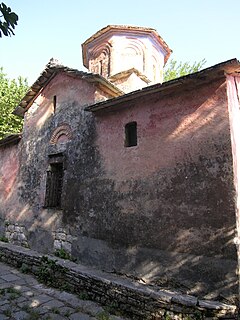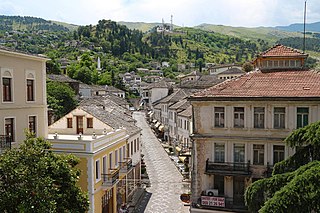
Ismail Halit Kadare is an Albanian novelist, poet, essayist and playwright. He has been a leading literary figure in Albania since the 1960s. He focused on poetry until the publication of his first novel, The General of the Dead Army, which made him famous outside of Albania. In 1996, he became a lifetime member of the Académie des Sciences Morales et Politiques of France.

In Albania, World War II began with its invasion by Italy in April 1939. Fascist Italy set up Albania as its protectorate or puppet state. The resistance was largely carried out by Communist groups against the Italian and then German occupation in Albania. At first independent, the Communist groups united in the beginning of 1942, which ultimately led to the successful liberation of the country in 1944.

Greater Albania is an irredentist concept of lands that are considered to form the national homeland by many Albanians, based on claims on the present-day or historical presence of Albanian populations in those areas. In addition to the existing Republic of Albania, the term incorporates claims to regions in the neighbouring states, the areas include Kosovo and the Preševo Valley of Serbia, territories in southern Montenegro, northwestern Greece, and a part of western Republic of North Macedonia.

Visoki Dečani, or simply Dečani is a medieval Serbian Orthodox Christian monastery located near Deçan, Kosovo. It was founded in the first half of the 14th century by Serbian king Stefan Dečanski.
Bilal Xhaferri, real name Bilal Xhaferr Hoxha, 2 November 1935 – 14 October 1986, was an Albanian poet and novelist, and a political dissident against the Albanian communist regime. He was born in Ninat, Konispol in southern Albania, and died in Chicago, USA.
Xhemail Hasani, known as Xhem Hasa and Xhem Gostivari, was an Albanian nationalist and Axis collaborator, in charge of the Balli Kombëtar's activities in the western regions of Macedonia, a part of Yugoslavia occupied by Fascist Italy and Nazi Germany during World War II.
Bule Naipi was a World War II Hero of Albania.

Tërbaç is a community in the Vlorë County, southwestern Albania. At the 2015 local government reform it became part of the municipality Himarë.
Safet Butka (1901—1943) was an Albanian professor, politician and nationalist. Son of famous patriot Sali Butka, he organized the student demonstrations in April 1939 during the Italian invasion and was interned in Ventotene. Upon his return he organized antifascist movements in his native region and was one of the founders of the nationalist organization Balli Kombëtar. Distressed by internal civil war in Albania, he killed himself in 1943.
Aziz Çami was an Albanian army officer and Balli Kombëtar commander. In 1920 he was a commander in the Vlora War. In the mid-1920s he was exiled after the restoration of monarchy as he was a supporter of Fan Noli and in 1931 he was arrested for an assassination attempt against King Zog I. During World War II he joined the ranks of the Balli Kombëtar and fought against Nazi Germany. He was assassinated in Tiranë in 1943.

The Dhuvjan Monastery also known as Monastery of Saints Quiricus and Julietta and Birth of the Virgin Mary Monastery, is a Byzantine monastery located in the western part of the village of Dhuvjan, Gjirokastër County, southern Albania.
Skënder Muço (1904–1944) was an Albanian lawyer and leader of Balli Kombëtar, one of the most important resistance organizations in Albania during World War II. Along with Musine Kokalari Muço founded the first social democratic party of Albania in 1943. In 1944 he was ambushed by German troops near Vlorë and executed three days later.

Gjirokastër is a city in southern Albania, on a valley between the Gjerë mountains and the Drino, at 300 metres above sea level. Its old town is a UNESCO World Heritage Site, described as "a rare example of a well-preserved Ottoman town, built by farmers of large estate". The city is overlooked by Gjirokastër Fortress, where the Gjirokastër National Folklore Festival is held every five years. It is the birthplace of former Albanian communist leader Enver Hoxha and notable writer Ismail Kadare.

"Free Albania" National Committee, also known as "Free Albania" National-Democratic Committee, also National Committee for a Free Albania or NCFA, was a political organization of post-World War II Albanian emigre in the Western countries. It was supported by CIA, placed as member of National Committee for a Free Europe. The committee aimed organizing the Albanian diaspora and cooperating with western powers into overthrown Enver Hoxha's Communist regime in Albania.
The committee creation started in Rome and was finalized in Paris in the summer of 1949.
Special Court for War Criminals and Enemies of the People, usually referred only as Special Court, was a Communist court set up during the spring of 1945 in the newly established Communist Albania, which carried on the trial against those labeled as "people's enemies" and "war criminals". It was based on a decision taken by the Anti-Fascist Council of National Liberation on 25 December 1944. Like the rest of the Eastern Europe, the purge against "Fascists" and "war criminals" became a central part of the construction of society based on the Soviet model.

The Architecture of Albania is a reflection of Albania's historical and cultural heritage. The country's architecture was influenced by its location within the Mediterranean Basin and progressed over the course of history as it was once inhabited by numerous civilisations including the Illyrians, Ancient Greeks, Romans, Byzantines, Venetians, Ottomans as well as modern Austro-Hungarians and Italians. In addition, missionaries, invaders, colonisers and traders brought cultural changes that had a large profound effect on building styles as well as techniques.

Erion Veliaj is an Albanian politician, who is currently serving as the 42nd Mayor of Tirana. Stemming from a civil society activism organization as the leader of “MJAFT!”, Veliaj joined the ranks of the Socialist Party of Albania in 2011, when he was appointed Secretary for Youth and Immigration.

















